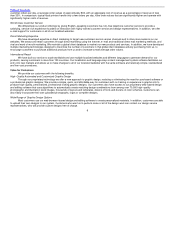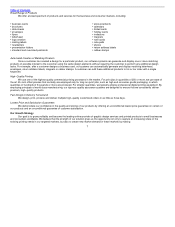Vistaprint 2006 Annual Report Download - page 19
Download and view the complete annual report
Please find page 19 of the 2006 Vistaprint annual report below. You can navigate through the pages in the report by either clicking on the pages listed below, or by using the keyword search tool below to find specific information within the annual report.
Table of Contents
Competition
The market for graphic design and print services is large, evolving and highly competitive. We compete on the basis of breadth of product
offerings, price, convenience, print quality, design content, design options and tools, customer and design services, ease of use, and production
and delivery speed. It is our intention to offer high−quality design and print at the lowest price point of any competitor in our market. Our current
competition includes one or a combination of the following:
Ÿself−service desktop design and publishing using personal computer software such as Broderbund PrintShop, together with a laser or
inkjet printer and specialty paper;
Ÿtraditional printing and graphic design companies;
Ÿoffice supplies and photocopy retailers such as Office Depot, FedEx Kinko’s, OfficeMax and Staples;
Ÿwholesale printers such as Taylor Corporation and Business Cards Tomorrow; and
Ÿother online printing and graphic design companies. We are aware of dozens of online print shops that provide some printing products
and services similar to ours. Further, we are aware of hundreds of online businesses that offer some limited custom printing services.
The level of competition is likely to increase as current competitors improve their offerings and as new participants enter the market or as
industry consolidation develops. Many of our current and potential competitors have longer operating histories, larger customer bases, greater
brand recognition and significantly greater financial, marketing and other resources than we do and may enter into strategic alliances to provide
graphic design and printing services with larger, more established and well−financed companies. Some of our competitors may be able to enter
into these alliances on more favorable terms than we could obtain. Additionally, these competitors have research and development capabilities
that may allow them to develop new or improved services and products that may compete with the services and products we market. New
technologies and the expansion of existing technologies, such as websites, e−mails and electronic files, which may serve as substitutes for printed
products, may increase competitive pressures on us. Increased competition may result in reduced operating margins as well as loss of market
share and brand recognition. We may be unable to compete successfully against current and future competitors, and competitive pressures facing
us could harm our business and prospects.
Government Regulation
We are not currently subject to direct national, federal, state, provincial or local regulation other than regulations applicable to businesses
generally or directly applicable to online commerce. The European Union, however, has extensive personal data privacy, electronic mail
solicitation and other directives. Several states of the United States have proposed legislation to limit the uses of personal user information
gathered online or require online companies to establish privacy policies. We do not currently provide individual personal information regarding our
users to third parties without the user’s permission.
Employees
As of June 30, 2006, we had 695 full−time employees, of which 243 were employed in Lexington, Massachusetts, United States; 40 in
Venlo, the Netherlands; 153 in Windsor, Ontario, Canada; and 259 in Montego Bay, Jamaica. None of our employees are represented by a labor
union or covered by a collective bargaining agreement, except that we are required to provide 32 of our employees in our Venlo facility with
compensation and benefits equal to or greater those provided in a collective
16
























